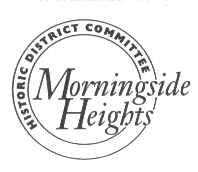 NEIGHBORHOOD
NEWSLETTER § MAY-JUNE 1998
NEIGHBORHOOD
NEWSLETTER § MAY-JUNE 1998 NEIGHBORHOOD
NEWSLETTER § MAY-JUNE 1998
NEIGHBORHOOD
NEWSLETTER § MAY-JUNE 1998
With this issue, the Morningside Heights Historic District Committee initiates a bi-monthly report on our efforts to gain landmark designation for this extraordinary neighborhood. On a high schist ridge heaved up by the Applachian revolution twelve million years ago, Olmsted's parks and drives, Riverside and Morningside, frame turn-of-century monuments rising within a residential fabric almost fully built 1896-1911. Noted churches, shaded campus ground, stately apartments, public statuary, interior treasures--landmark designation of this formative site of the City Beautiful movement is overdue.
To protect the cornices, doors, transoms, lanterns, fencing that enliven our streets, to ensure sensitive alteration, to heighten awareness of an irreplaceable legacy--Historic District designation is our best tool. Historic Districts are established by the NYC Landmarks Law to preserve areas of special character or historic interest across the city and enable us, like residents of Greenwich Village, Carnegie Hill, Hamilton Heights, and Chelsea, to bring legal protection to our neighborhood. Within a district, the Commission reviews any construction for compatibility in materials, scale and character. Its staff provides expert advice on managing historic properties. Its research files detail an architectural profile. The Heights, with its tremendous cultural reach, belongs actively engaged within the nation's historic preservation effort.
Initially, we are proposing a District extending east from Riverside Drive and Park--landmarked in 1980. These residential blocks were built first by private owners and then developers transforming wild grass fields and goat runs opened to the city by the IRT's arrival in 1904. These were the city's renaissance years. Enthusiasm for buildings as public art spilled from civic monuments at midtown -- and from McKim's Columbia campus -- into residential design. Adjacent to Grant's Tomb and Low Library, architects trained at L'Ecole Des Beaux Arts, Hebrew Technical Union, Columbia, vied in embellishing "modern" apartment house fronts with classical elements. It was all dynamic: the surge in building pace, the widely advertised rentals, the ballooning growth in construction budget and scale, the architects' upward shift in scope. The area marks the transition from single family houses built midblock before 1900 to the soaring "high class" apartments lining Riverside Drive by 1910. It constrasts George Pelham's Grant Court at 610 W. 113th St. with his later Versailles Palace at 605; Neville & Bagge's 1898 tenement, 600 W. 114th St., with "Riverside Mansions" built 1911 at 410 Riverside Drive. It presents early work of C.P.H.Gilbert, Henry Otis Chapman, W.L. Rouse, Schwartz & Gross, charts Gaetan Ajello's career, 1910 to 1923, and frames the gradual turn in facade and lobby style, as richly articlate surface was sheared, robust ornament was flattened, from Beaux Arts to Deco. It enlarges the story of historic New York.
Among the earliest houses in the proposed District, those shown here at
604-616 W. 114th St., designed by Frank A. Land in 1896, are prime examples of
the midblock buildings, 116th to 11th Streets, especially vulnerable to
demolition and high rise replacement. On Broadway, stalwart Ajello, Blum &
Blum and Neville &  Bagge apartment houses owned by Columbia hold invincible, despite
severe damage from stripping; Viking Hall at 113th St. shines again under
improved University maintenance promising to renew the "Boulevard," as it was
known 1900. Riverside Drive showcases the latest and grandest of the District's
achievements. It is the earliest midblock house that are most at risk. Smaller
than zoning allowance but critical to this historic narrative enclosed by the
District's proposed boundaries, these need the protection offered by District
designation.
Bagge apartment houses owned by Columbia hold invincible, despite
severe damage from stripping; Viking Hall at 113th St. shines again under
improved University maintenance promising to renew the "Boulevard," as it was
known 1900. Riverside Drive showcases the latest and grandest of the District's
achievements. It is the earliest midblock house that are most at risk. Smaller
than zoning allowance but critical to this historic narrative enclosed by the
District's proposed boundaries, these need the protection offered by District
designation.
At midblock, find period buildings are already gone--to Columbia's Schapiro Hall, Bank St. College, St. Hilda's/St. Hugh's, to parking lots awaiting development, with threats of unregulated construction now pending. The urgent preservation challenge confronts residents along the Drive who have a stake in stable streetscapes reaching to Broadway. Visitors to the Heights, students from around the world, NYC walkers can now glance directly at the rich array of early century styles. Does public interest in this standing architectural archive outweigh unregulated institutional expansion or for-profit development? We say yes. Ensuring present and future enjoyment of these streets as they were first envisioned and built is the genuine long term gain. Frank Lang's seven elegant narrow houses, with find roman brick and limestone entrance relief, may represent his sole surviving work. It is a pleasure to have them here. These small houses were standing when the Heights began its spiraling rise. They form a notable match with the adjacent 1898 tenement. These and the residential blocks soon to come connect us, as Brendan Gill put it in his final piece for the New Yorker, "to the potency of the past".
MORNINGSIDE HEIGHTS HISTORIC DISTRICT
COMMITTEE
P.O. Box 250344 Columbia Station, New York, NY 10025 -
1535
URL: http://www.preserve.org/mhhd/
e-mail: mhhd@juno.com
phone: (212) 665-8535
 |
These web pages are made possible with public funds from the New York State Council of the Arts, a State Agency |
last revised January 21 2001
by: Will Chan